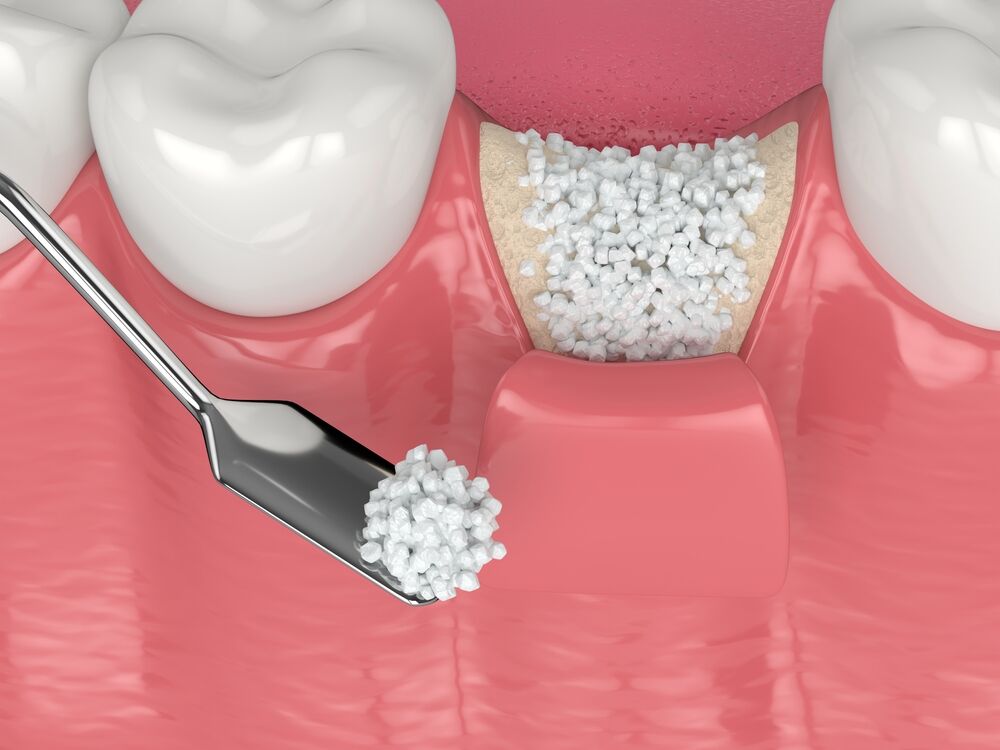Discovering you have one or more missing teeth can lead to considering artificial replacements and a dental bone graft is a key procedure in this journey. In this blog post, we aim to provide you with a thorough understanding and procedure of dental bone grafts, from how they work to the recovery stages.
What is a Dental Bone Graft?
A dental bone graft serves to add volume and density to the jaw in areas affected by bone loss. This grafting material can be sourced from your body, a human tissue bank, or an animal tissue bank, and in certain instances, it may be synthetic.
How Does a Dental Bone Graft Work?
Once the bone graft is in place, it acts as a scaffold, creating a conducive environment for your natural bone tissue to grow and regenerate. In some cases, platelet-rich plasma (PRP) from your own blood may be combined with the bone graft to enhance healing and tissue regeneration.
Who Needs a Dental Bone Graft?
Patients experiencing bone loss in the jaw may benefit from a dental bone graft, especially in scenarios like tooth extraction, planning for a dental implant, jaw reconstruction before dentures, or addressing bone loss due to gum (periodontal) disease.
Types of Dental Bone Grafts
There are four main types of dental bone grafts: socket preservation, ridge augmentation, sinus lift, and periodontal bone graft. Each type serves specific purposes, such as preventing socket collapse, increasing jawbone width and volume, addressing sinus drop-down, and supporting existing teeth affected by gum disease.
Dental Bone Graft Procedure
Before initiating the dental bone graft procedure, your dentist will conduct a thorough oral examination to assess the overall health of your teeth, gums, and jaw. Utilizing dental X-rays or scans, they will evaluate the extent of bone loss. Subsequently, a detailed discussion about your treatment options will take place, and a personalized treatment plan will be devised to address your specific needs.
Dental Bone Graft Surgery Process
To ensure a pain-free experience, your dental provider will administer a local anesthetic to numb the targeted area. Following the numbing, a small incision will be made in your gums, enabling access to the jawbone. Then gum tissue will be gently moved back to reveal the affected area and the exposed jawbone will be thoroughly cleaned and disinfected to create an optimal environment for the grafting process.
Now the dentist will apply the chosen bone grafting material to repair the bone defect. In many cases, a protective membrane is placed over the graft for added security. After completing the grafting, the gum tissue is carefully repositioned, and the incision is closed using stitches, ensuring a secure and stable closure.
- Post-Dental Bone Graft Care:
After undergoing a dental bone graft, it is normal to experience some common side effects. - Pain, Swelling, and Bruising:
Expect mild to moderate pain, swelling, and bruising in the initial days. These are typical and should gradually subside. Pain relievers can be used as directed by your dentist. - Antibiotic Usage:
Your dentist may prescribe antibiotics to prevent infection. It is crucial to adhere to the prescribed antibiotic regimen to promote optimal healing. - Bone Fragments:
It’s common to observe small bone fragments resembling grains of salt or sand emerging from the graft site during the initial days. While generally not alarming, it’s advisable to contact your dentist to ensure proper healing.
Possibility of Dental Bone Graft Failure
While dental bone grafts boast high success rates, it’s essential to acknowledge the potential for failure, particularly in individuals who smoke or have specific medical conditions. Indications of dental bone graft failure encompass:
- Worsening Pain or Swelling:
An escalation of pain or swelling beyond the initial week could signify potential issues with the graft. - Pus or Drainage:
Presence of pus or drainage from the bone graft site indicates a possible complication and warrants attention. - Gum Recession:
If the gums begin to recede, pulling away from the teeth, it may suggest an insufficient response to the graft. - Lack of Improvement in Jawbone Volume:
A lack of observable enhancement in jawbone volume might signal an unsuccessful grafting process.
Advantages of Dental Bone Grafts
Dental bone grafts offer numerous benefits, enhancing eligibility for dental implants and other restorative procedures. This transformative procedure aids in restoring the jaw to its original form, particularly in cases of trauma, tooth loss, or gum disease.
Potential Risks and Complications
While generally safe, dental bone grafts carry inherent risks, including:
- Infection:
The possibility of infection, though relatively low, requires monitoring and prompt intervention if detected. - Heavy Bleeding:
Excessive bleeding, while uncommon, is a potential complication that merits attention. - Nerve Damage:
Though rare, nerve damage can occur, emphasizing the importance of precision during the grafting procedure. - Anesthesia Complications:
Complications related to anesthesia, though infrequent, necessitate careful consideration and management.
Recovery and Future Outlook
Recovery from a dental bone graft typically involves a short period of discomfort, with most individuals returning to normal activities within a week or two. The complete healing process spans three to nine months or longer, contingent on factors like graft type and individual healing capacities.
Maintaining open communication with your dental provider and adhering to post-operative instructions ensures a positive recovery outlook, ultimately contributing to the success of the dental bone graft..
Conclusion
At the end, Mission Implant Center emphasizes more on the pivotal role of dental bone grafts in restoring jaw health, function, and overall quality of life. If concerns about jawbone deterioration arise or bone grafting required, our dedicated team is here to guide you through the comprehensive journey of oral restoration.
So, schedule your appointment today for more information!
